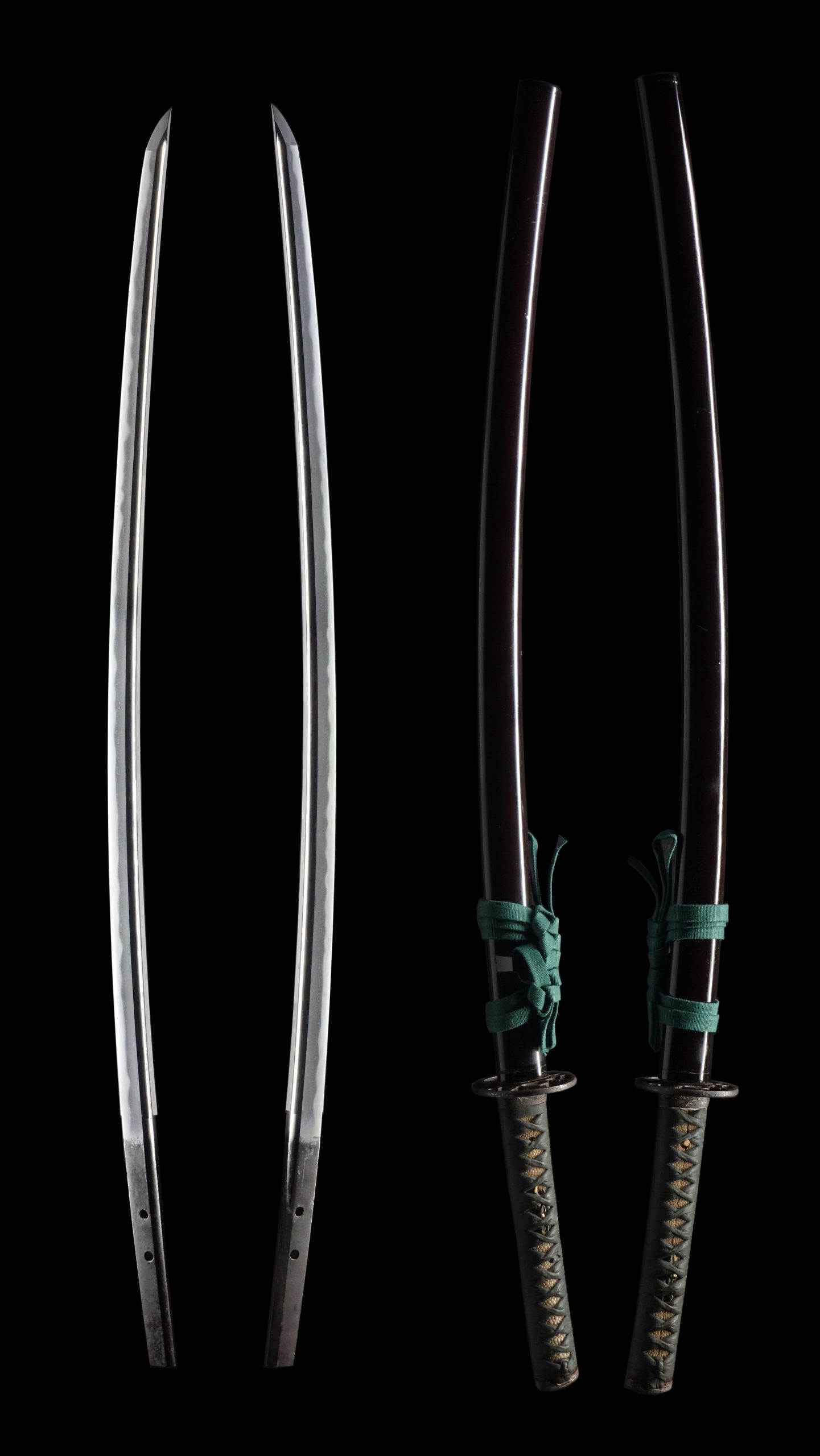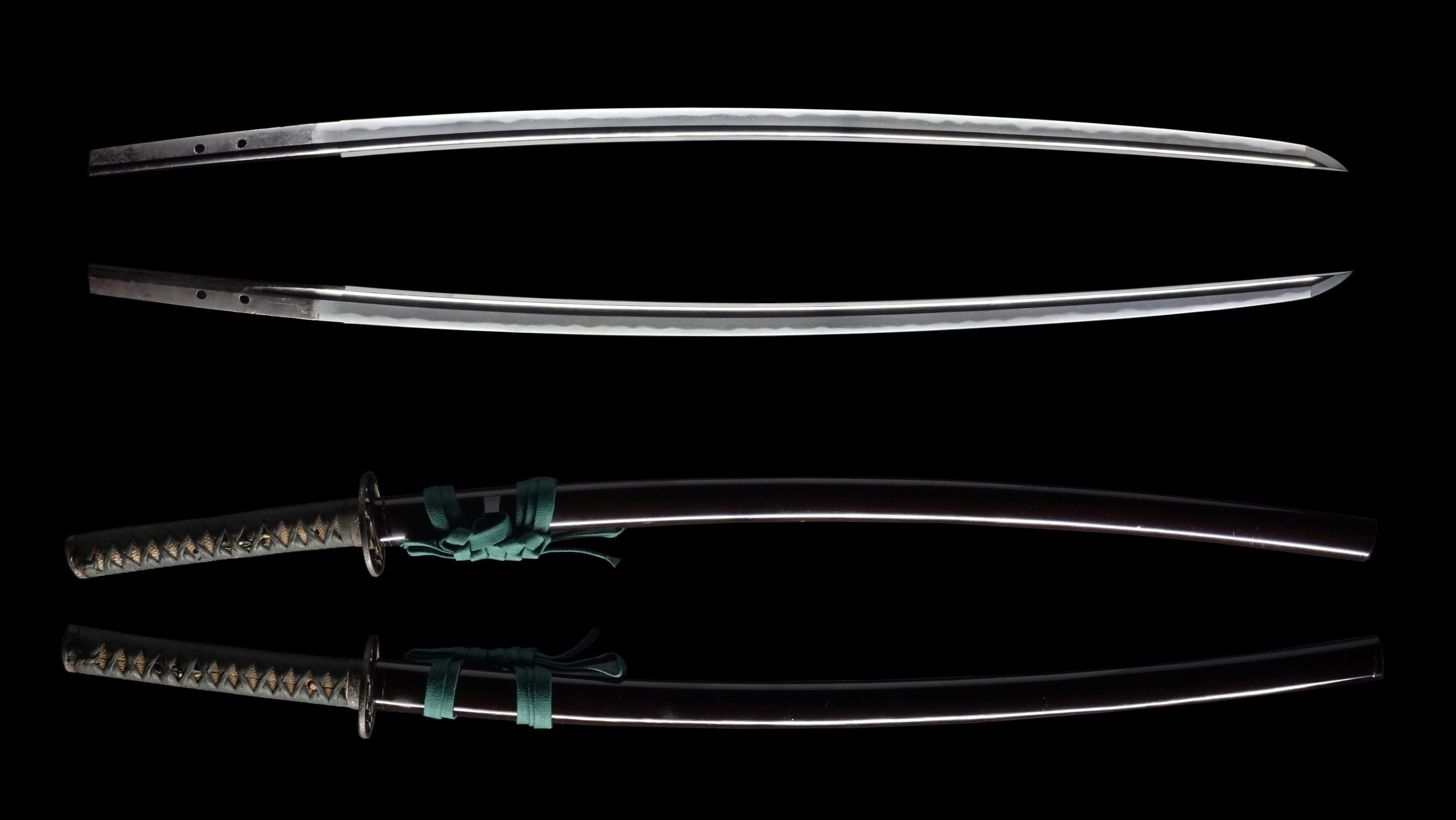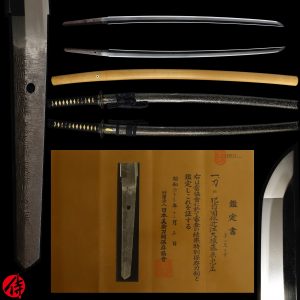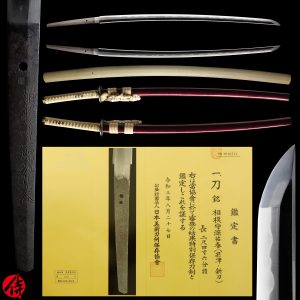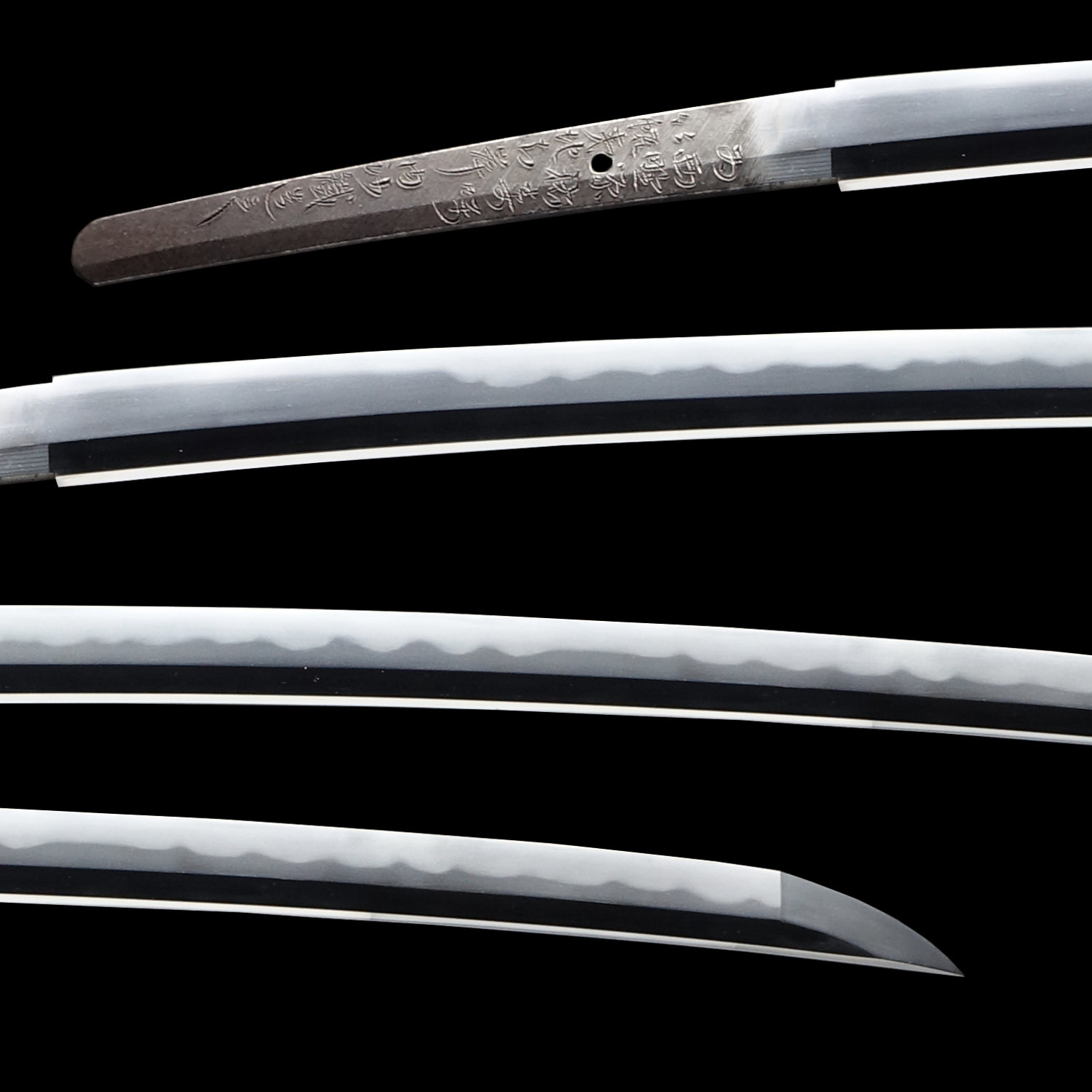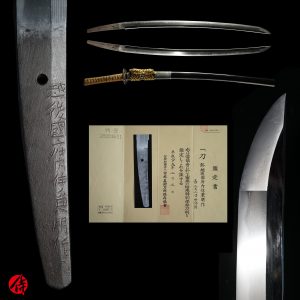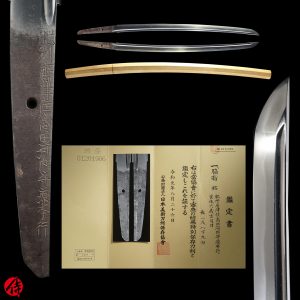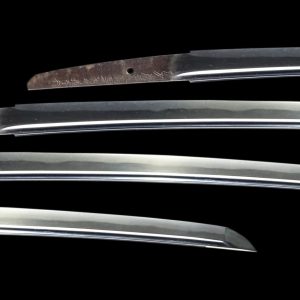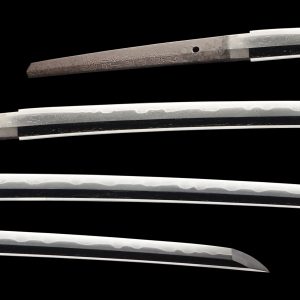Antique Japanese Sword Katana Attributed to Nagamori with NBTHK JUYO TOKEN Certificate
【Description】
Summary
This blade is attributed to Bizen Osafune Nagamori (備前長船長守), who was active during the mid-Nanbokucho period (Mid 14th century: Approx. 650 years ago). Based on the blade’s characteristics and available records, NBTHK attributed it to Nagamori, while there is no signature due to Suriage, a Japanese sword terminology to describe shortened blades.
He belonged to Bizen Osafune school (headquarter) in today’s Okayama prefecture. Among many branches, he worked for Chogi (Nagayoshi) school run by his father named Nagayoshi. Nagamori is one of the most prominent figures during the Nanbokucho period in Bizen province. He was a direct descendant of the founder of Bizen Osafune school.
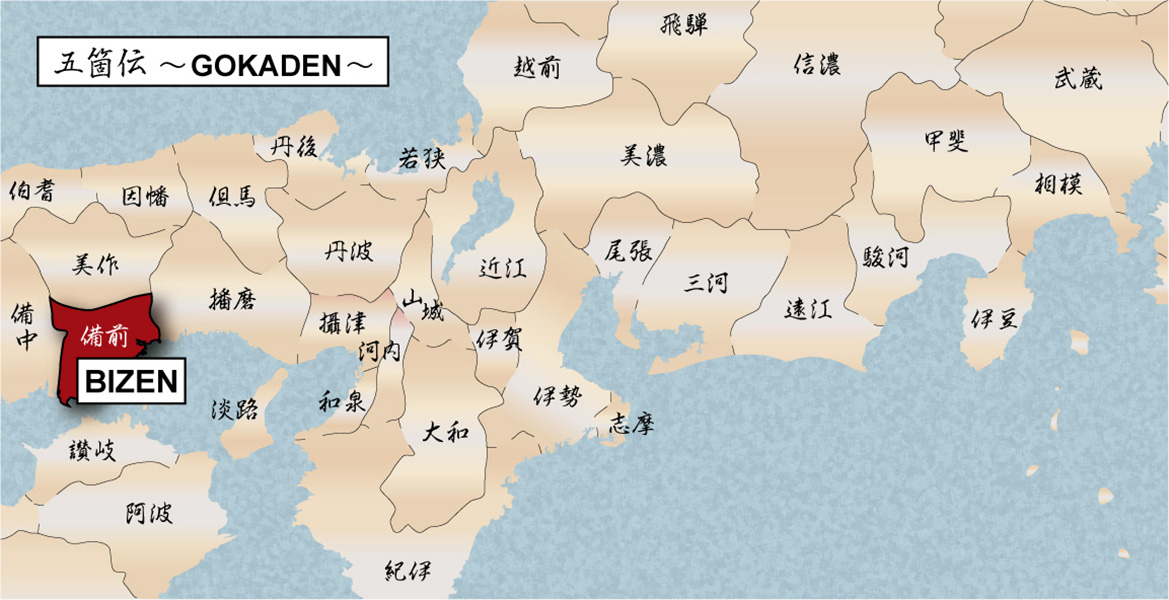
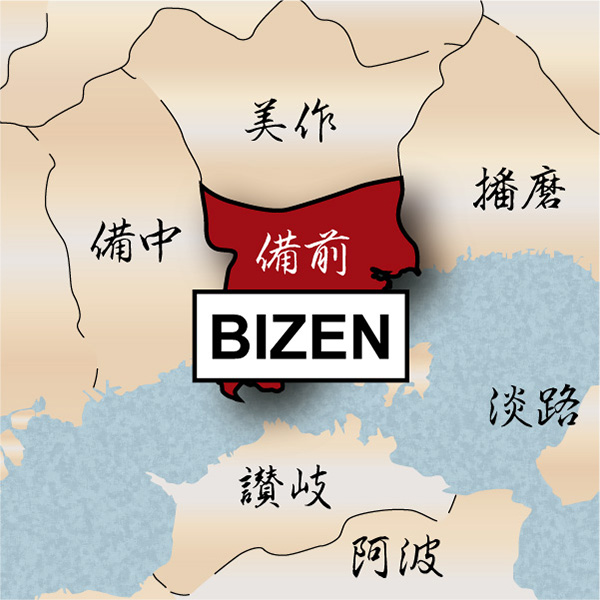
About Chogi (His father)
Chogi was the son of Mitsunaga (光長), whose grandfather was the founder of Bizen Osafune school (Mitsutada). Mitsunaga’s father was Sanenaga (真長). Chogi is known as one of 10 apprentices of Soshu Masamune (相州正宗), a renowned swordsmith in Japanese history. Masamune was a master of SOSHU DEN, one of the five traditions of Japanese sword forging. Bizen province was also famous for its unique sword forging tradition, BIZEN DEN.
It is said that Chogi mastered the unique Japanese sword-forging technique called Soden Bizen, which is the combination of SOSHU Den and BIZEN DEN. The swords forged in Soden Bizen were very popular among Samurai back then. His son, Nagamori, also mastered this high level of this craftsmanship from his father. And, Nagamori was surrounded by prominent figures, growing up to become a great swordsmith.
This History of Bizen Osafune School
It is said that Osafune school was founded by Mitsutada (光忠), who was active during the mid-Kamakura period. Bizen Osafune school was the biggest one of all other schools in Bizen province, and they received many orders from feudal lords or renowned Samurai. They were called Osafunemono and beloved by Samurai warriors.
Among the swordsmiths who belonged to this school, Nagamitsu, Sanenaga, and Kagemitsu are known as Osafune Sansaku, the three renowned Osafune swordsmiths. There are also four other prominent swordsmiths who were from Bizen Osafune school. They are called Osafune Shiten-no, the four masters of Osafune school. They are Nagamitsu, Kanemitsu, Chogi (Nagayoshi), and Motoshige.
BIZEN is located near the Chugoku Mountains, where iron sands, one of the essential materials for making Japanese swords, were abundant. Furthermore, BIZEN swordsmiths had close access to Yoshi River, where they could find water and charcoal. This geological location contributed to the swordsmiths forging high-quality refined blades. We presume BIZEN was quite active in sword-forging from ancient times. It is said that BIZEN DEN was created by groups of swordsmiths there during the late Heian era (Late 12th century ). These ancient swordsmiths in Bizen province are called Ko-Bizen (Old Bizen) swordsmiths. By inheriting the sword forging techniques from Ko-Bizen swordsmiths, the Bizen Osafune school flourished from the mid-Kamakura period.
This blade is appraised as a JUYO TOKEN(重要刀剣) issued by NBTHK (Nihon Bijutsu Touken Hozon Kyokai:日本美術刀剣保存協会). This authentication paper was only given to authentic Japanese swords, exceptionally well preserved and of high quality with artistic value. JUYO is one rank higher than Tokubetsu Hozon. To be eligible for a Juyo Token, it needs to be appraised as a Tokubetsu Hozon Token first. It is extremely rare for an antique Japanese sword to be appraised as JUYO TOKEN, and it is highly desirable among Japanese sword collectors.
【 Blade】
Cutting Edge Length(Nagasa): 71.6 cm (28.1 inches)
Curvature(Sori):1.6 cm( 0.62 inches)

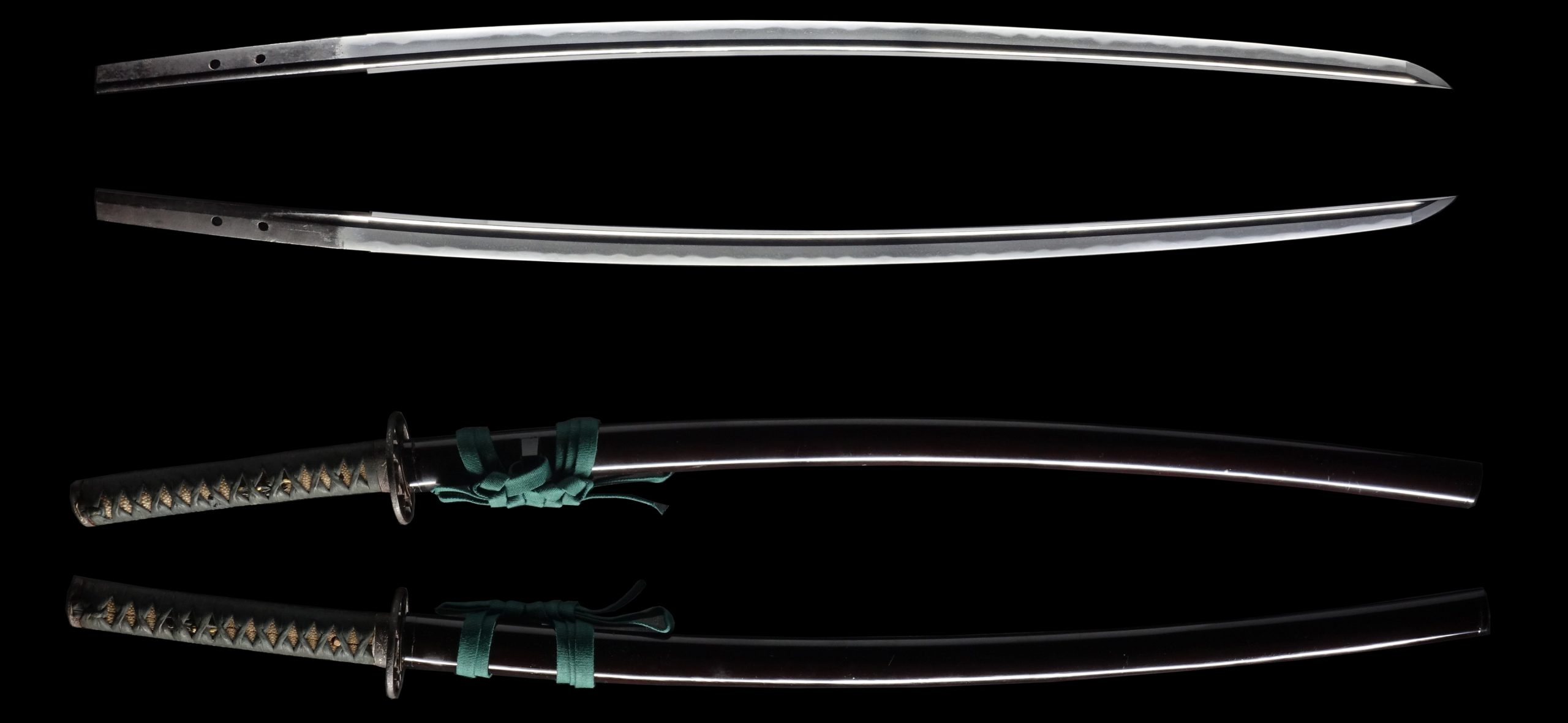
Hamon:
The crystalline structure which forms along the cutting edge of a blade as a result of the hardening process
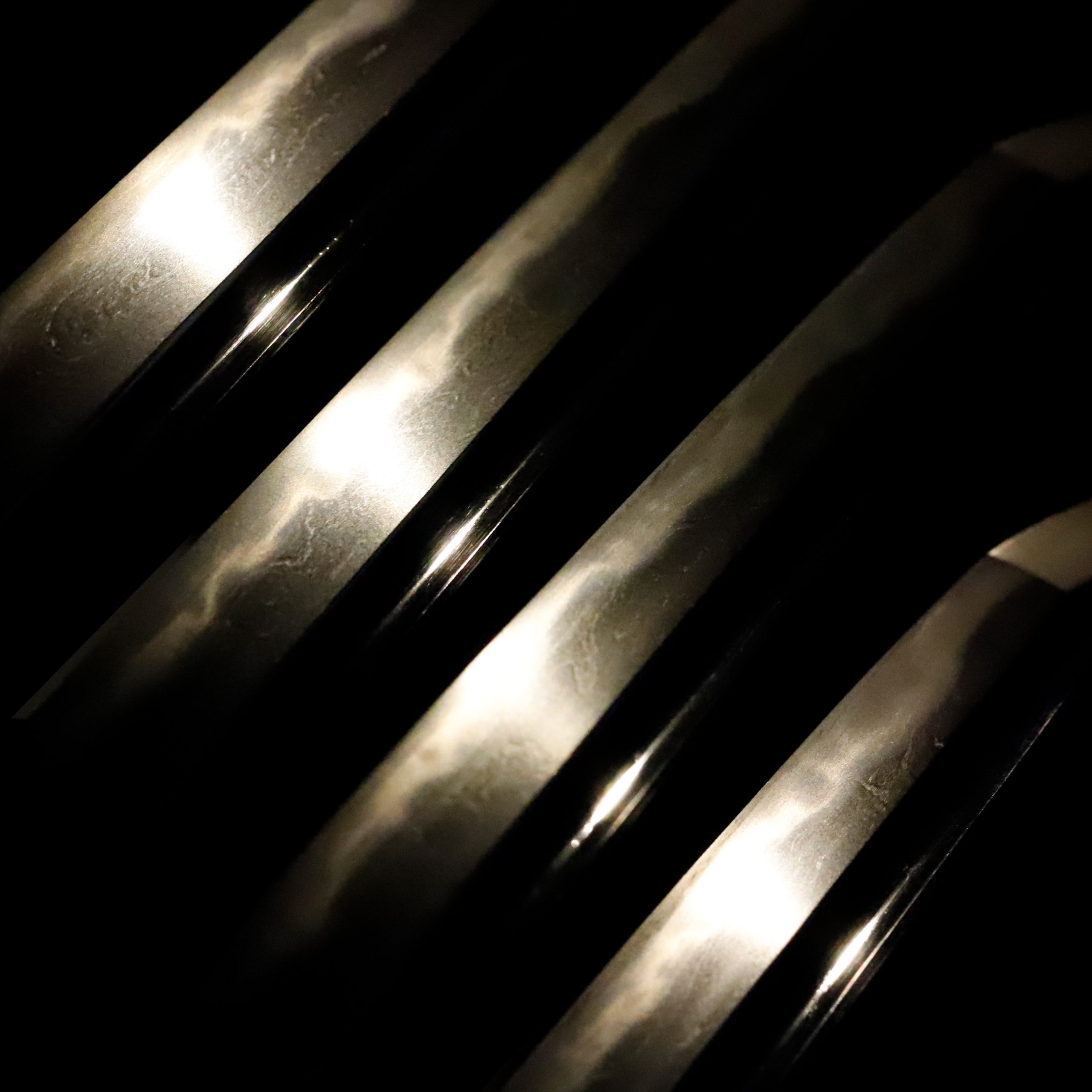
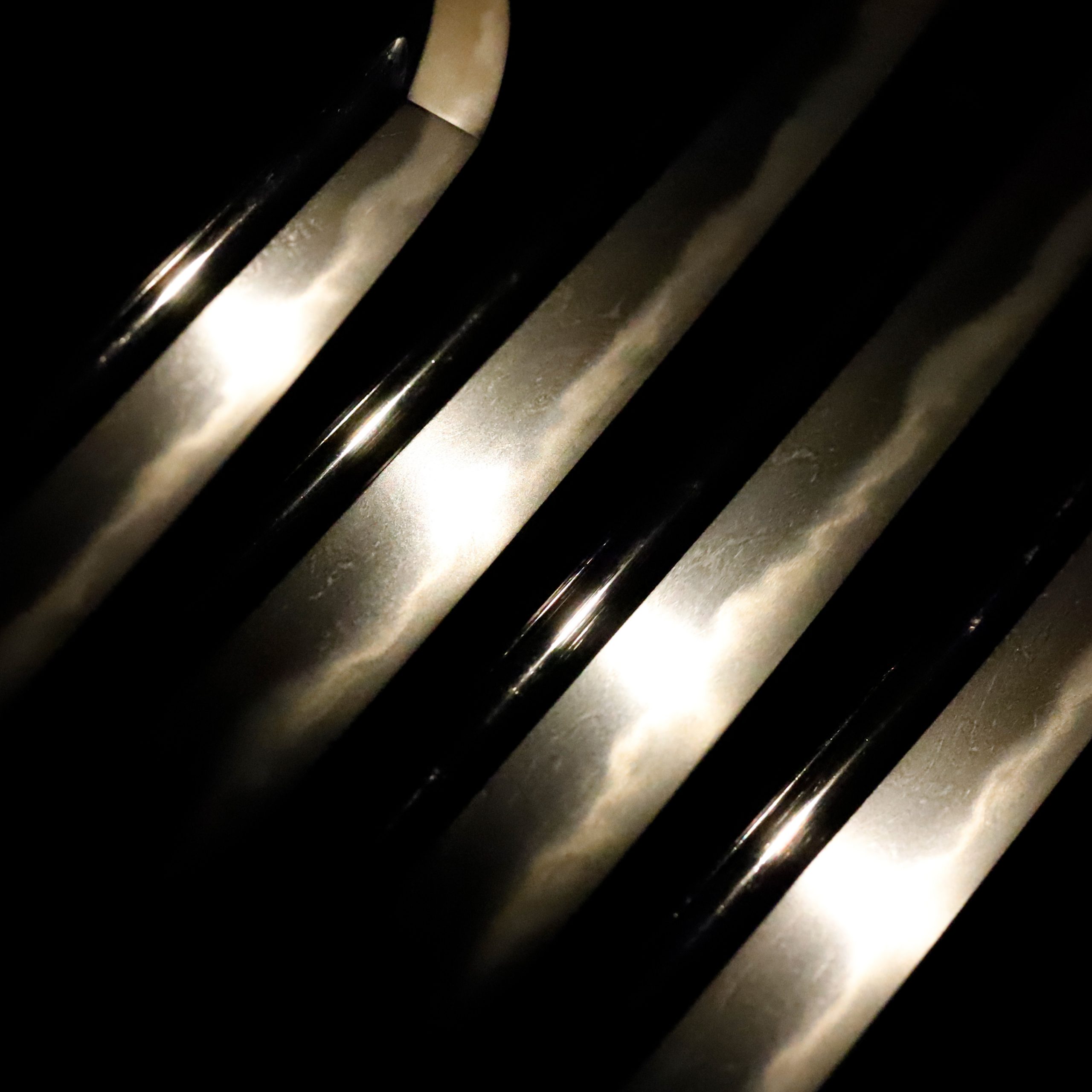
Jimon(Jihada):
visible steel surface pattern created by folding and hammering during forging process
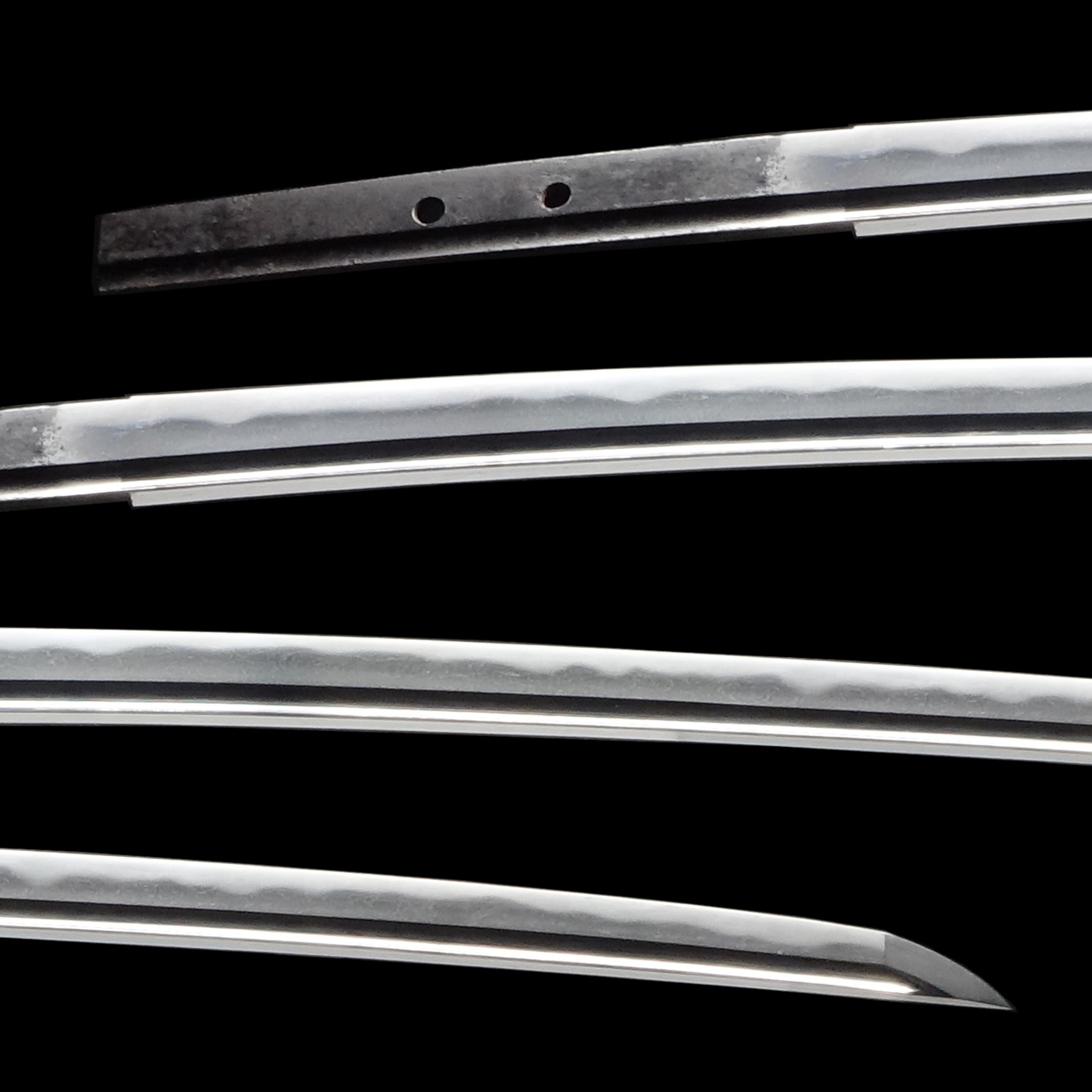

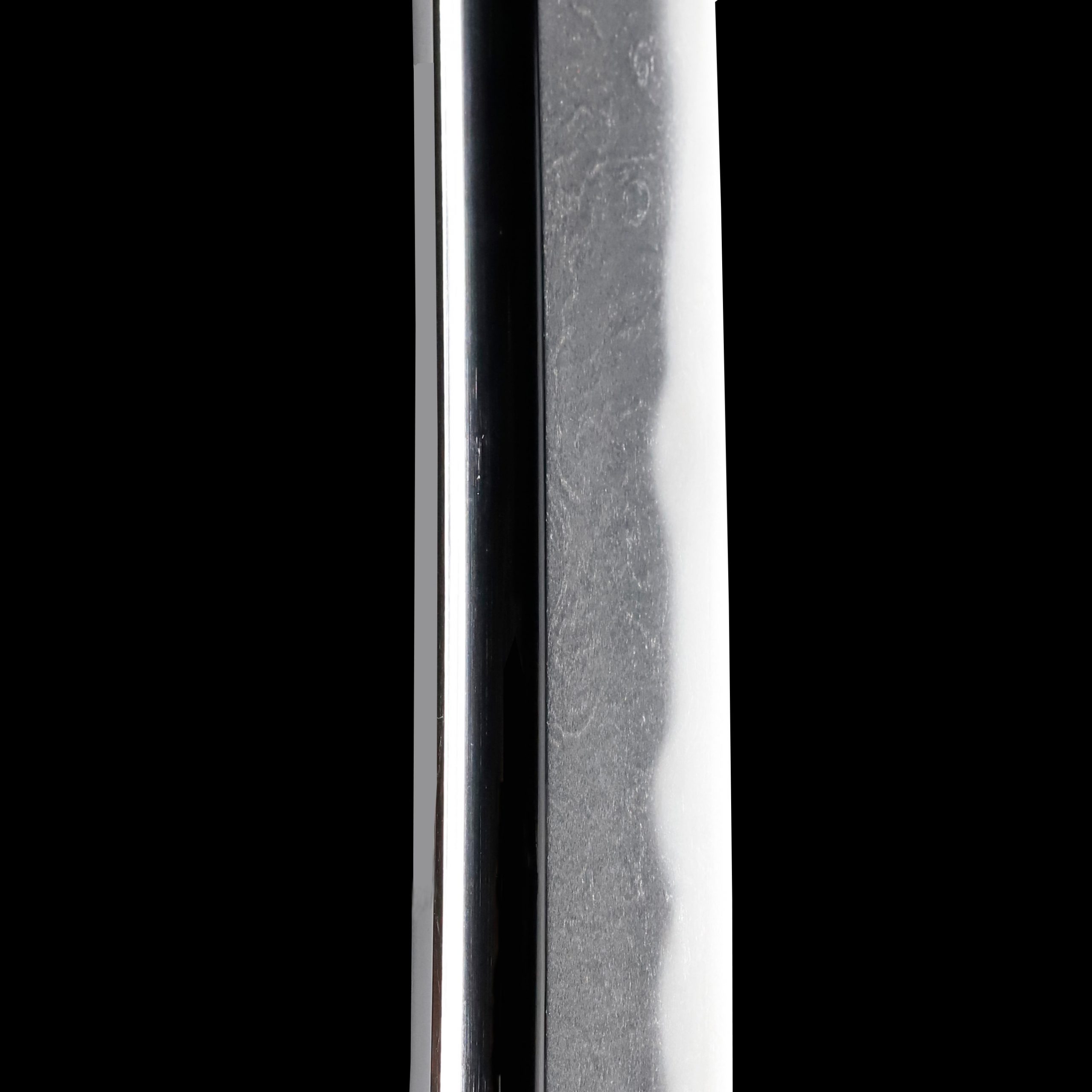
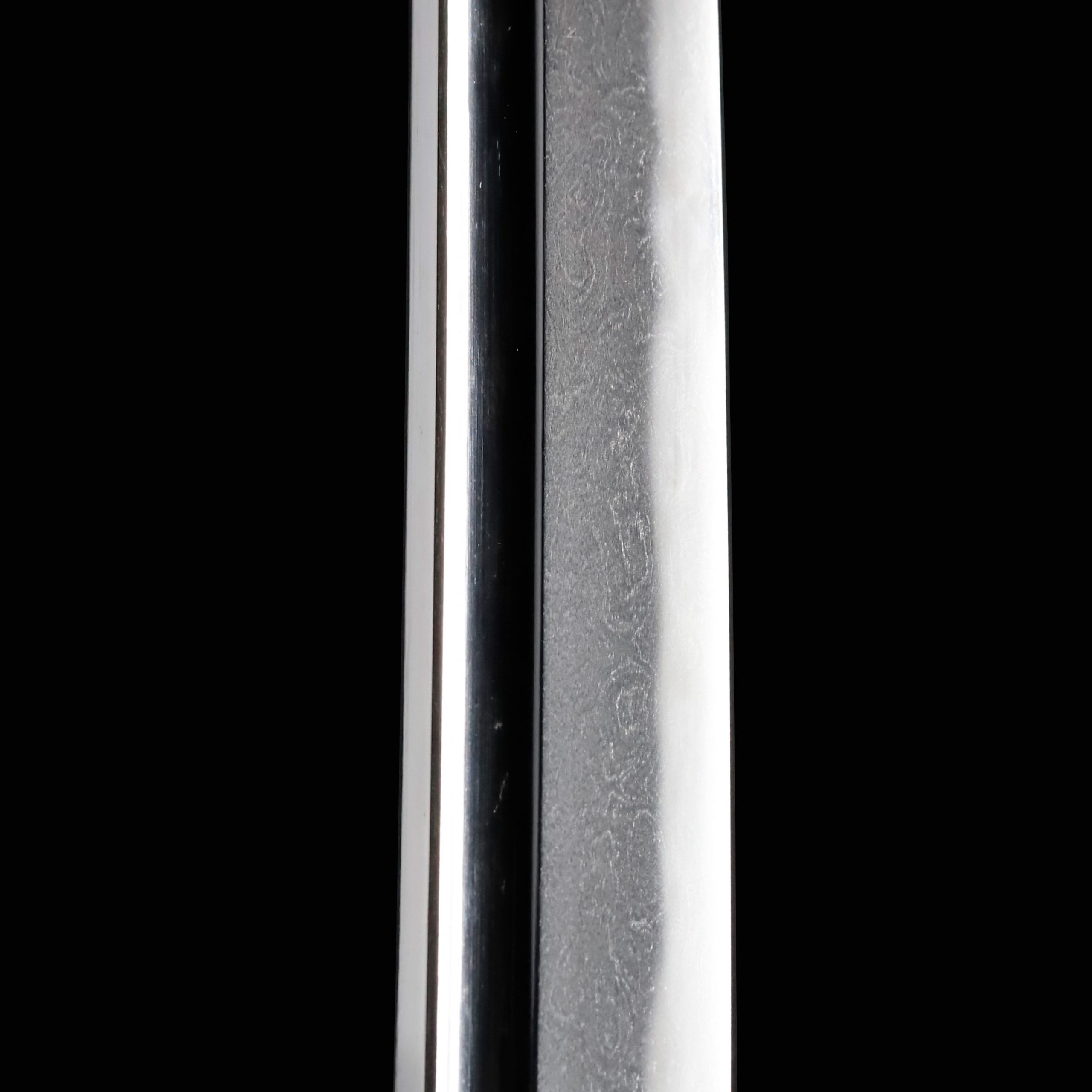
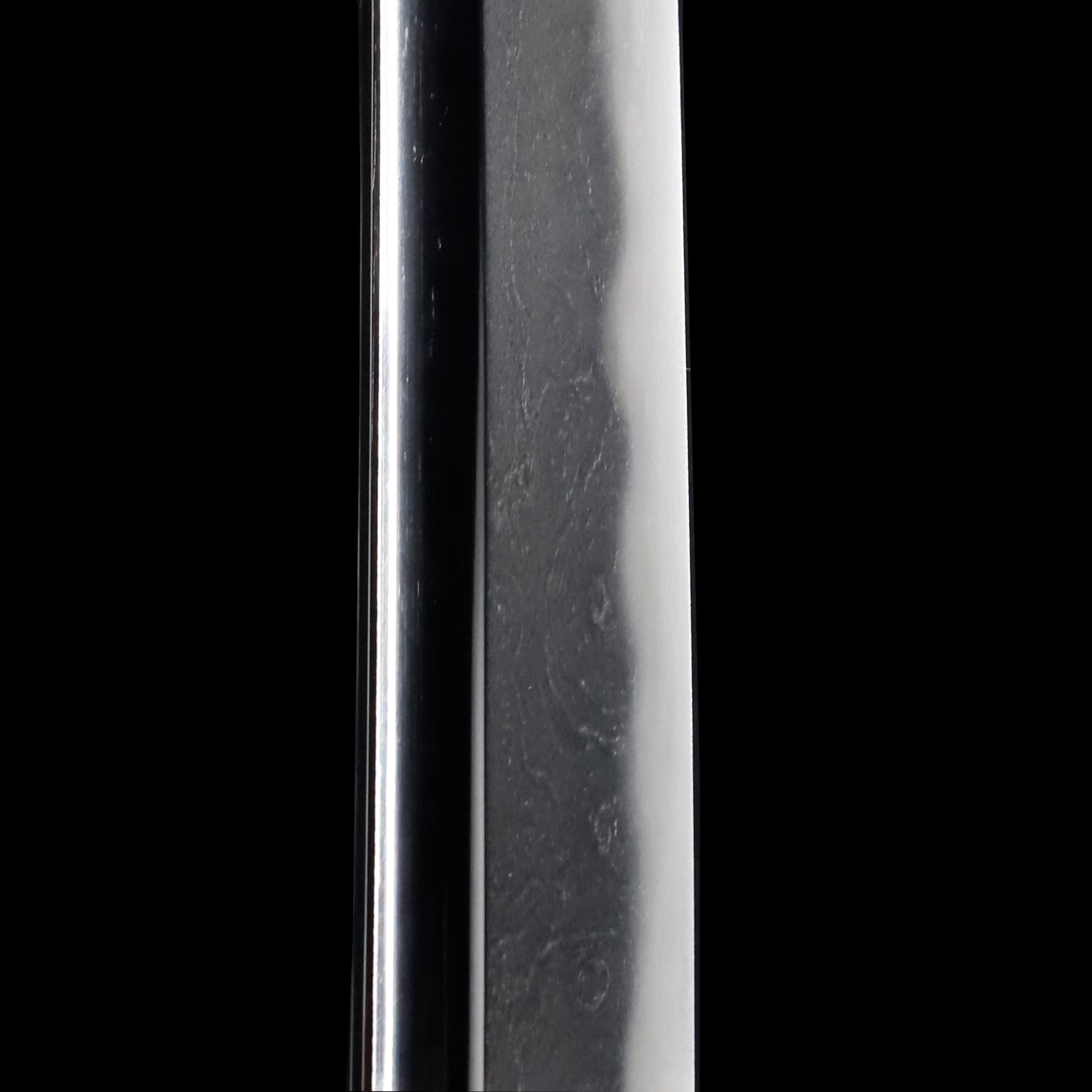
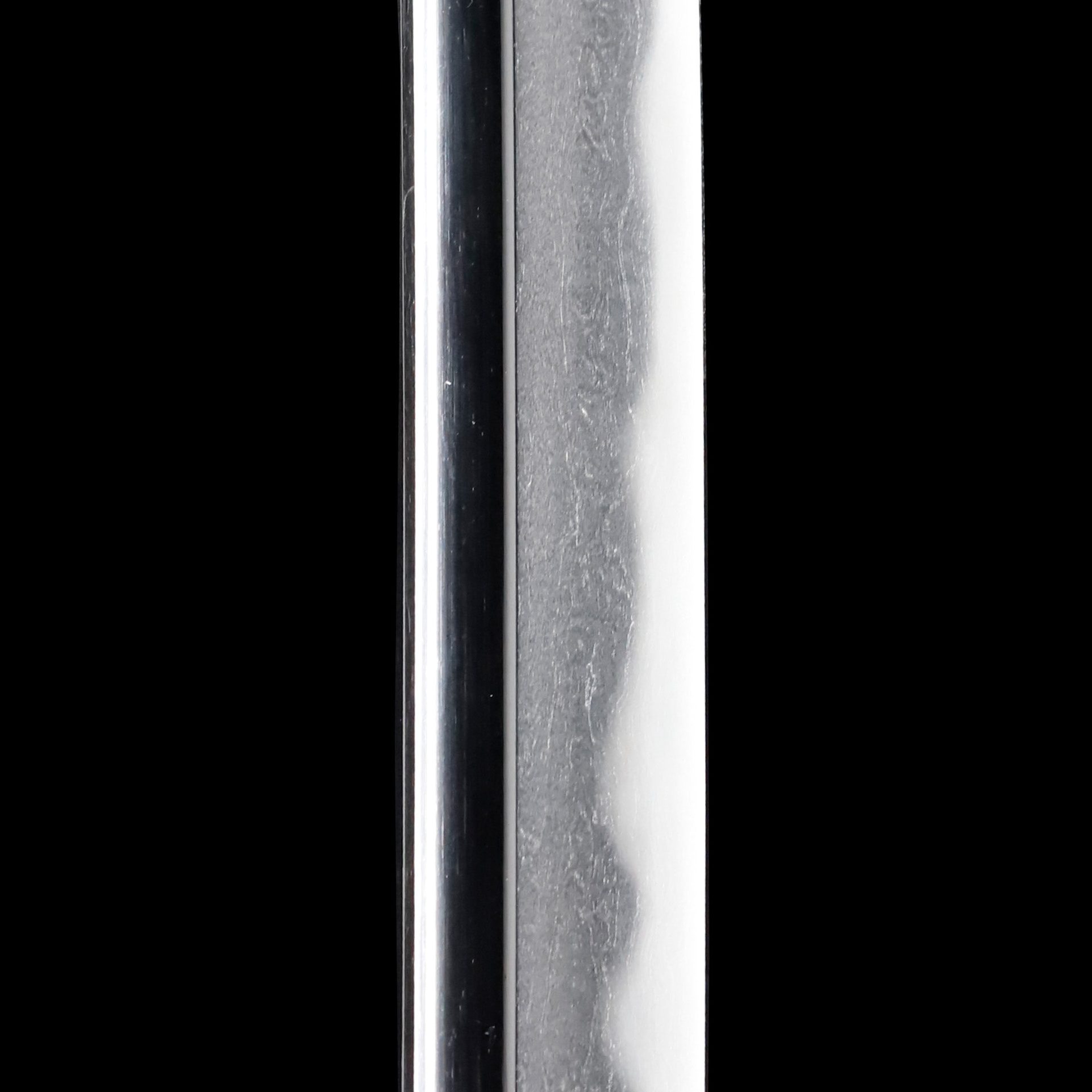
Nakago:Nakago is the tang of the Japanese sword.
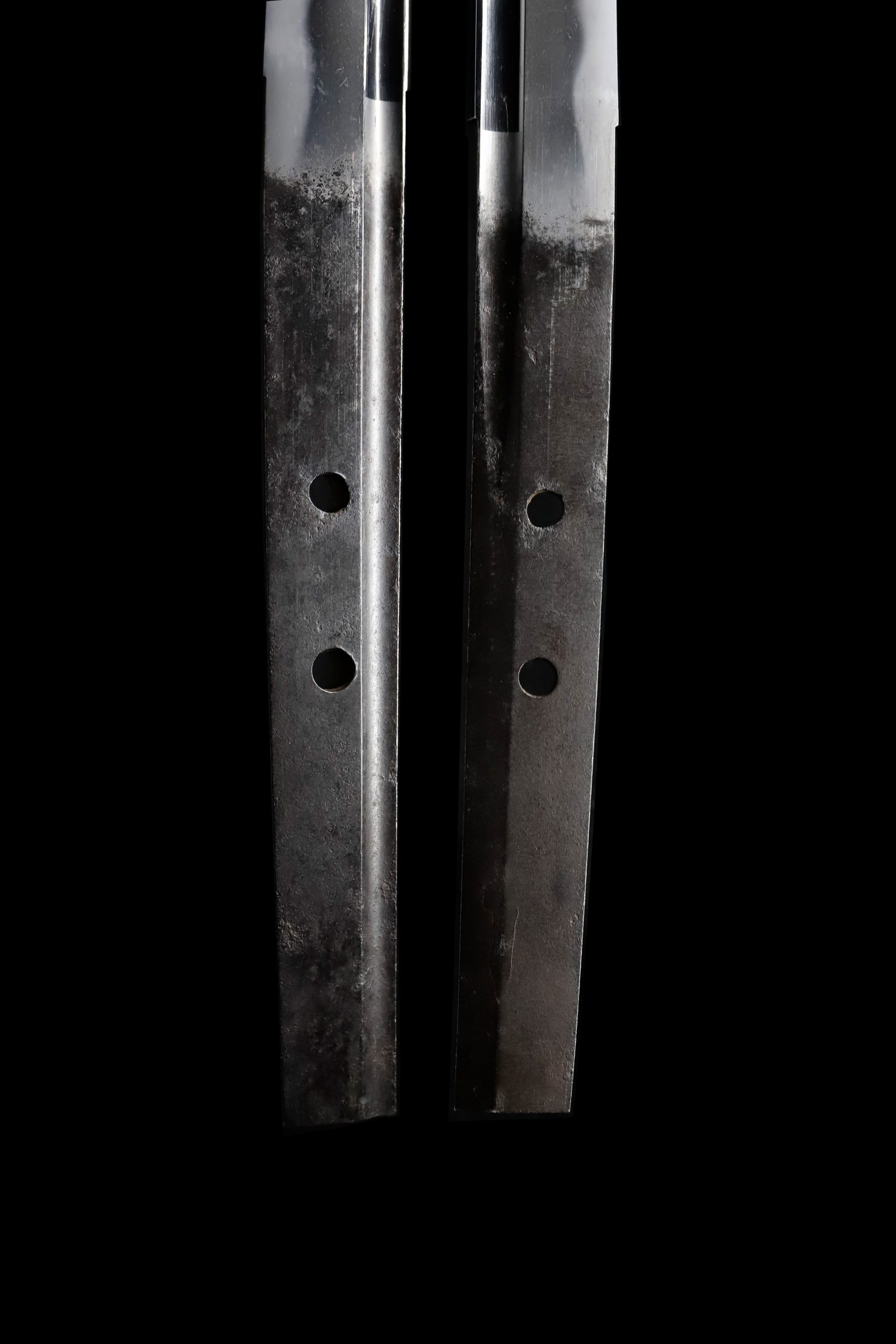
Koshirae: Koshirae is the mounting of the Japanese sword. There are several parts that consist of Koshirae such as Saya(Scabbard), Tsuka(Handle), Tsuba(Handguard).
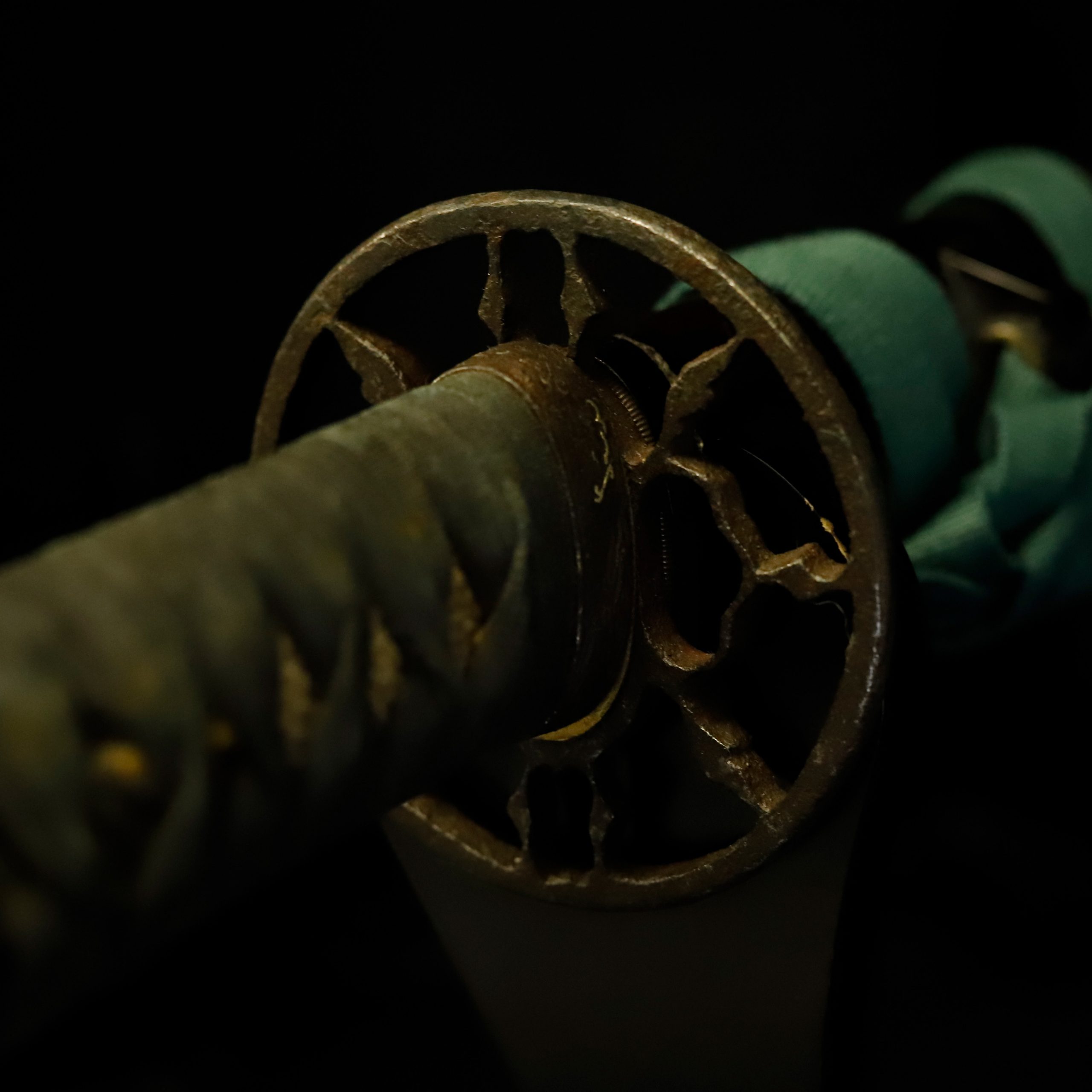
Fuchi-Kashira:A pair of matching sword fittings that cover the upper and bottom parts of its sword hilt.
On the Fuchi part, you would find a geometric pattern. Although engraved lines are a little hard to see due to wear and aging, we think this design is categorized as the Saya Gata (紗綾形) pattern. It is a type of continuous design, and many Samurais loved it. According to a theory, this motif was brought from a foreign country to Japan in the Momoyama period (1568-1600). The Saya Gata pattern has a graceful appearance and represents the longevity and prosperity of the family. On the Kashira part, you would find a wood-grain tone pattern. Same as the Fuchi part, here is also decorated with golden inlay (estimated brass inlay).
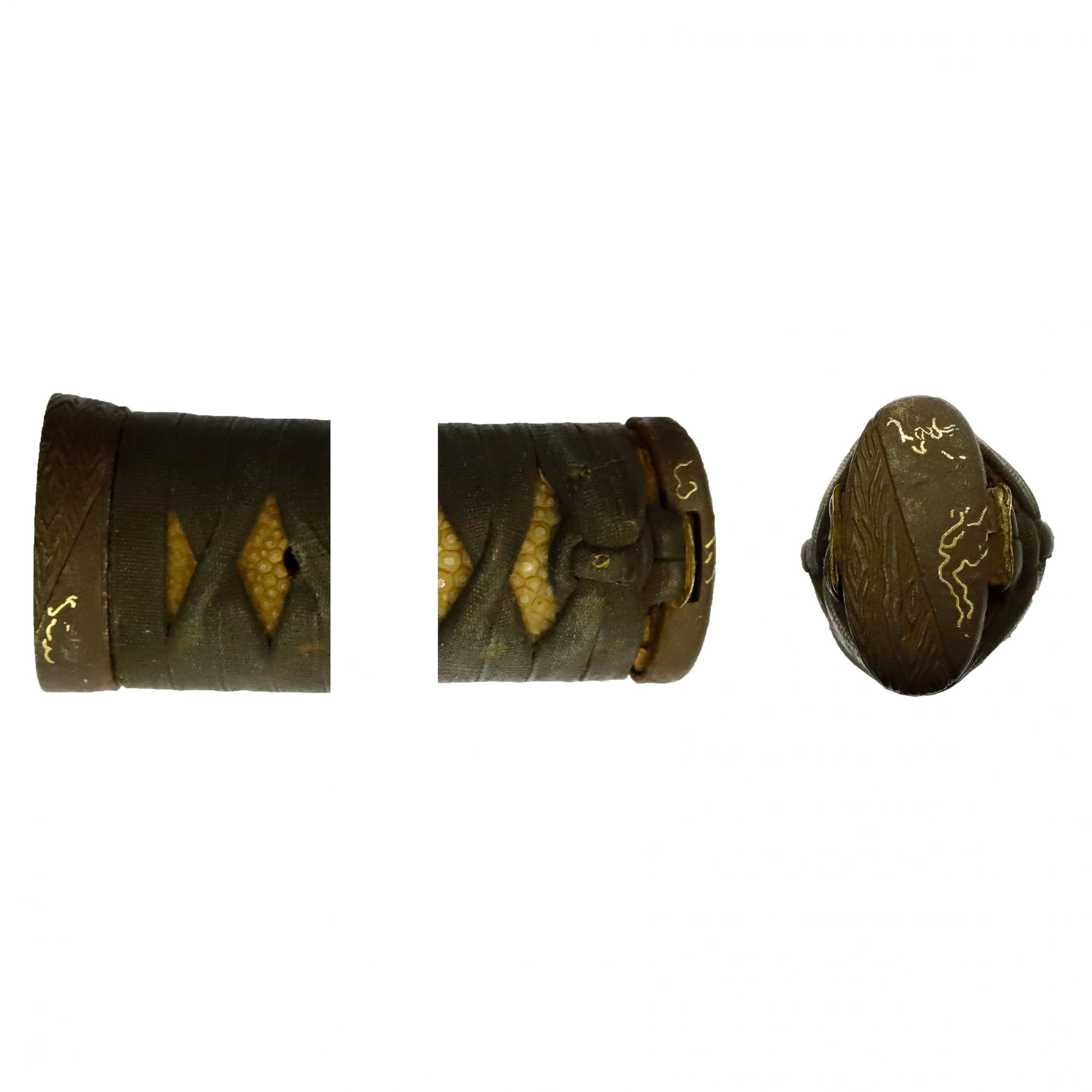
Tsuka and Menuki:Tsuka is the handle of the Japanese sword and Menuki is its decoration.
A kind of plant is the motif of this Menuki. You would see small fruits and leaves. We are unsure what it is; however, we guess it might be the Nanten (南天, nandina) or the Donguri (団栗, acorn). People have regarded the nandina as an auspicious plant since ancient times. Its Japanese name Nanten has the same pronunciation as the word Nanten (難転); Nan-ga Tenjiru (難が転じる). It means “change misfortune to good fortune.” Based on this wordplay, it is said many Japanese people grew this plant believing it would protect them from fire or evil spirits in the Edo period.
According to a theory, there is an idea that the acorn is the symbol of life, fertility, and eternal life In Northern Europe. Although it is uncertain if a similar idea existed in Japan at that time, possibly people regarded it as a good-luck item. In addition, the Kuri (栗, chestnut), which is similar to an acorn, was also incorporated into the sword mounting motif. There is a variation of the chestnut motif: the Kachi-Guri (搗栗, dried chestnuts). As its name, Kachi-Guri has the same pronunciation as a Japanese word: Kachi (勝ち, victory). We imagine Samurais appreciated it as a good-luck omen to hope the success in battles. The former owner of this Katana might have wished some of its good luck would come to him.

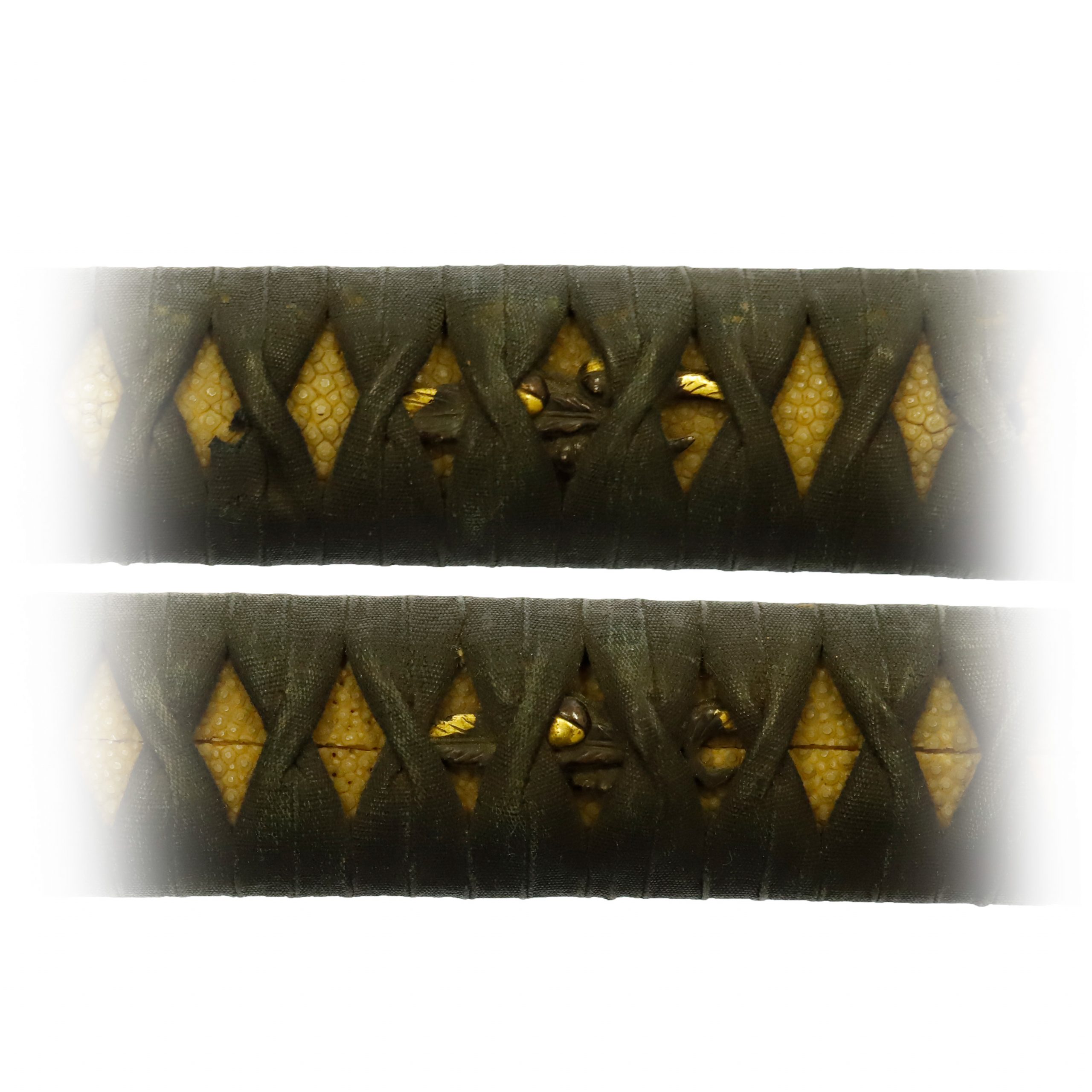
Tsuba and Habaki:Tsuba is the handguard for the Japanese Sword and Habaki is the equipment to make the blade not touch its scabbard inside. It prevents the blade from getting rusty and chipped.
Oval-shaped Tsuba that has Kozuka and Kougai holes. This Tsuba has a symmetrical design; almost the same shape patterns are evenly arranged. It is challenging to judge the origin of this pattern, but here we would like to introduce a possibility. Wild geese are migratory birds that represent fall. This bird is designed not only as a realistic figure but also as a very simplified shape: Hiragana (ひらがな, a kind of Japanese letter) “he (へ)” shape that sometimes makes also wild goose.
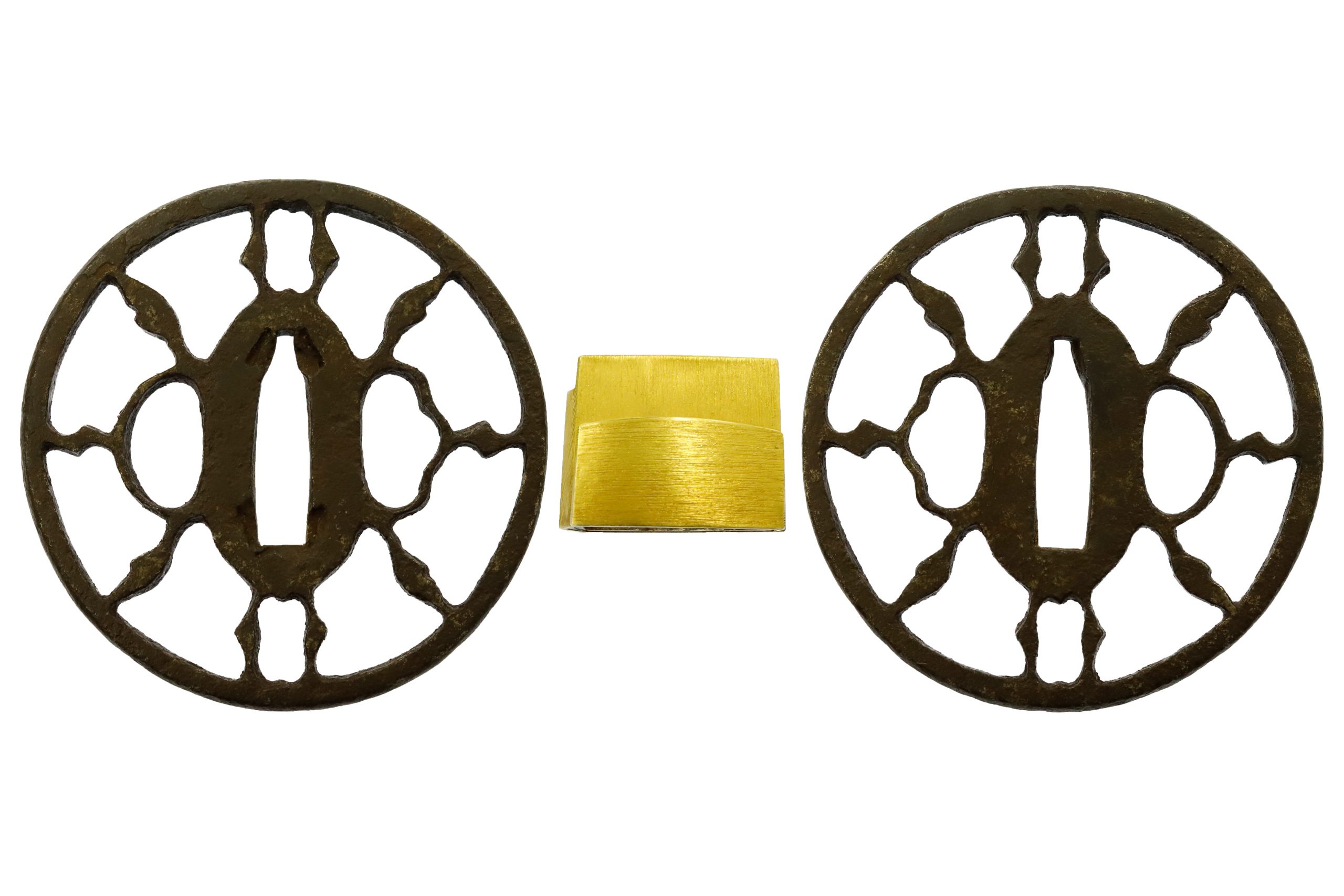
Saya: Saya is the scabbard for the Japanese sword.
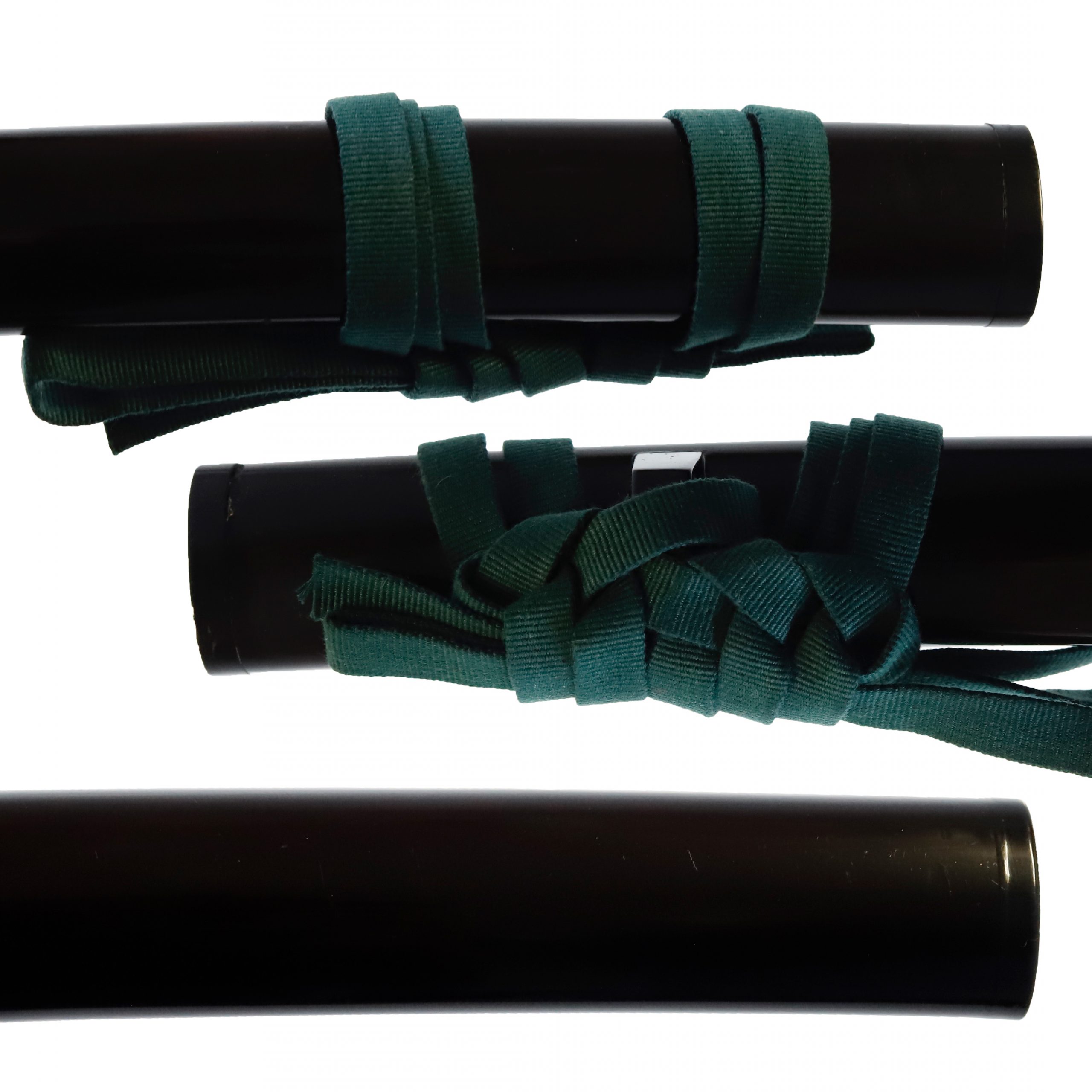
Authentication Paper:NBTHK JUYO TOKEN Certificate for the blade (No. 6095)
NBTHK, also known as Nihon Bijutsu Touken Hozon Kyokai (the Society for the Preservation of the Japan Art Sword), is one of the oldest Japanese sword appraising organizations in modern-day Japan. They authenticated the blade on Nov 1st in the 52nd year of Showa (1977). They appraised it as JUYO TOKEN, the blade exceptionally worth preserving for Japanese society. The purchaser will receive this original certificate as well. We can also translate what is written into English and make a PDF file for your record if you request.
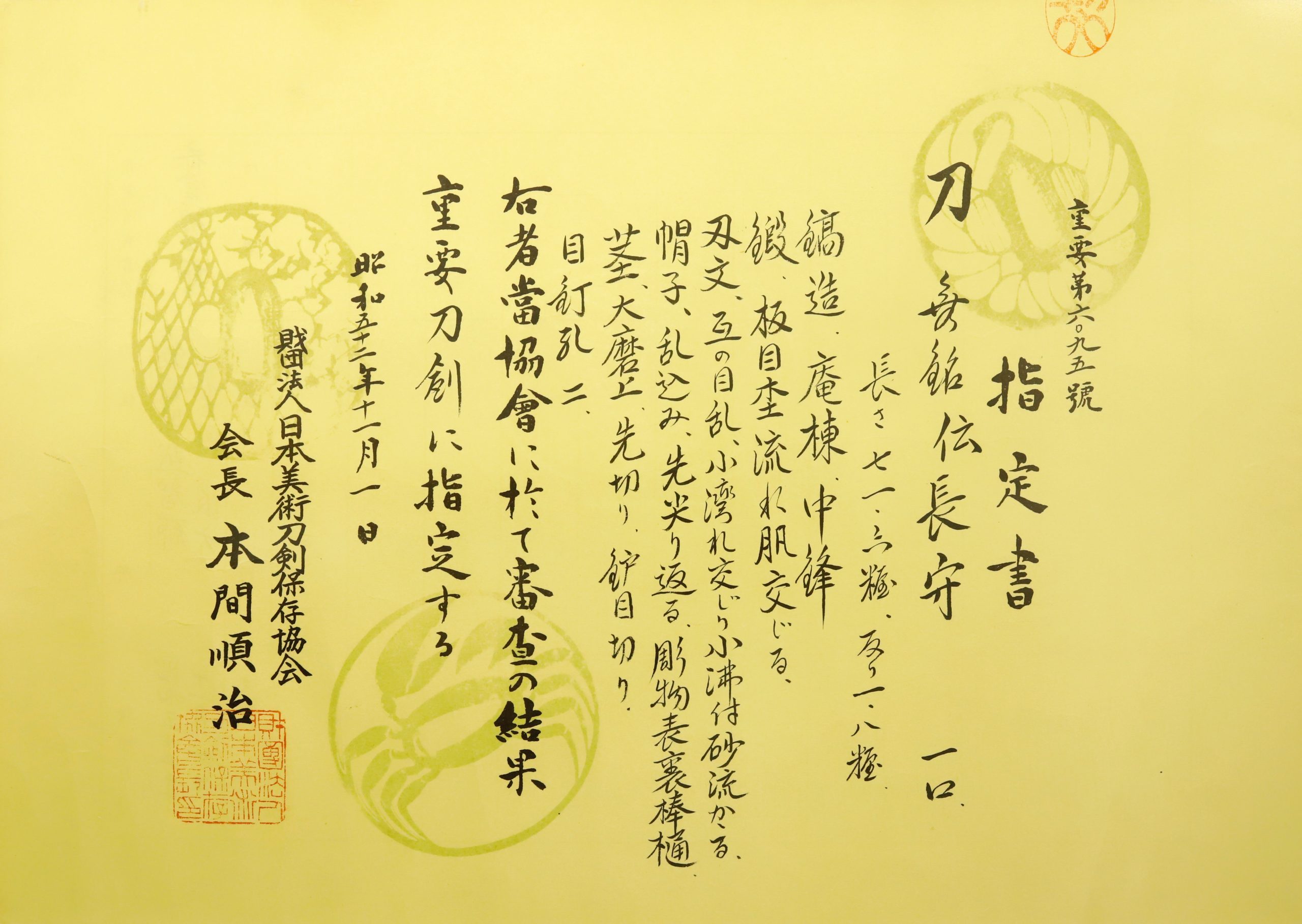

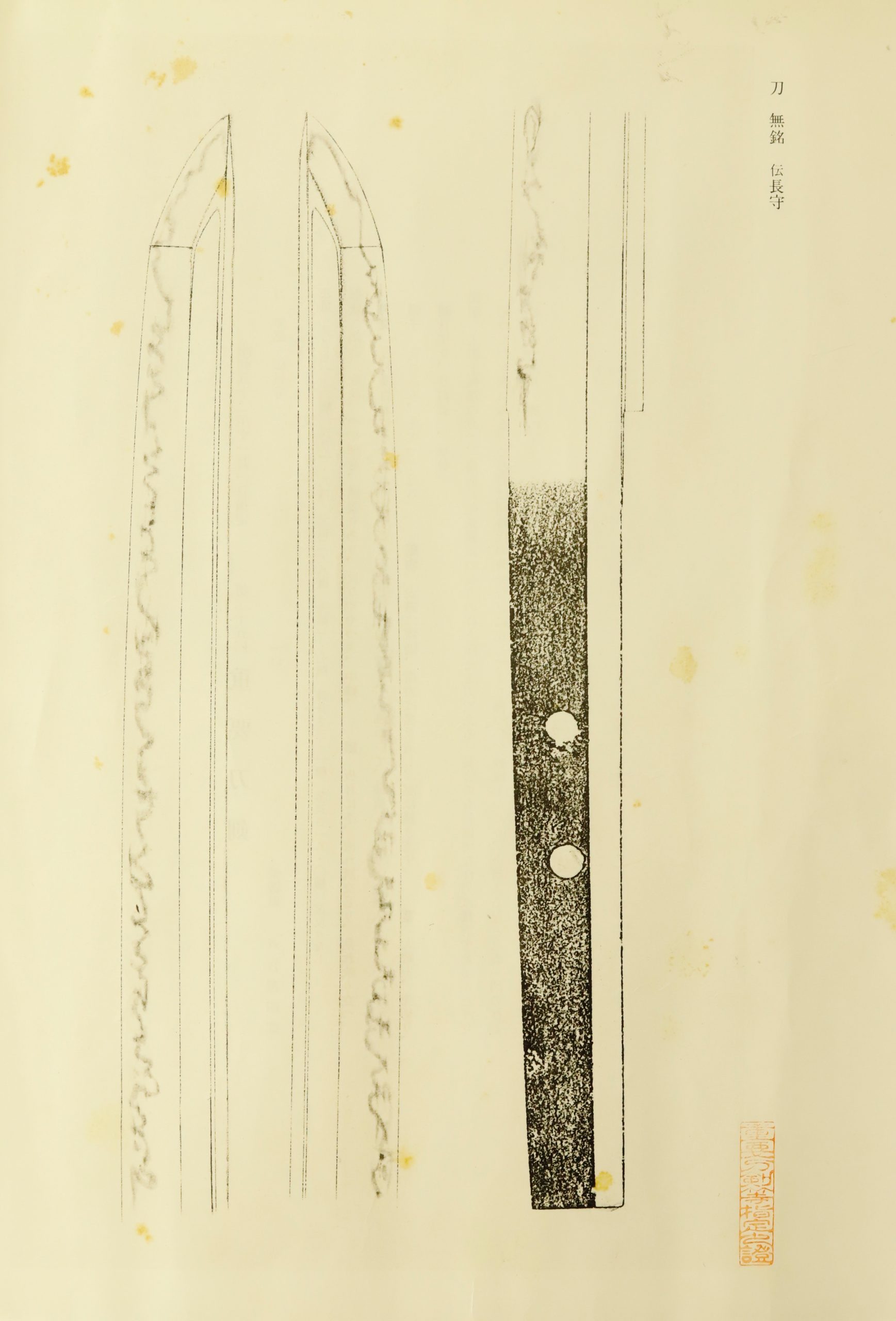
Registration Number : Hiroshima 53137
The Board of Education in Hiroshima prefecture issued a registration paper for this sword . It is called Jyu Token Rui Torokusho(銃刀剣類登録証). Bunkacho(The Agency for Cultural Affairs) acknowledges a Japanese sword with this paper as a work of art.
The sword needs to be traditionally hand-forged and made of Tamahagane carbon steel to be registered in the system. With this paper, its owner in Japan can legally own an authentic Japanese sword. Based on this registration number, we will apply for its export permit.
This paper will need to be returned to the board of education when the sword is being shipped abroad, but you can receive a copy of it. An English translation of this registration paper is available on request.
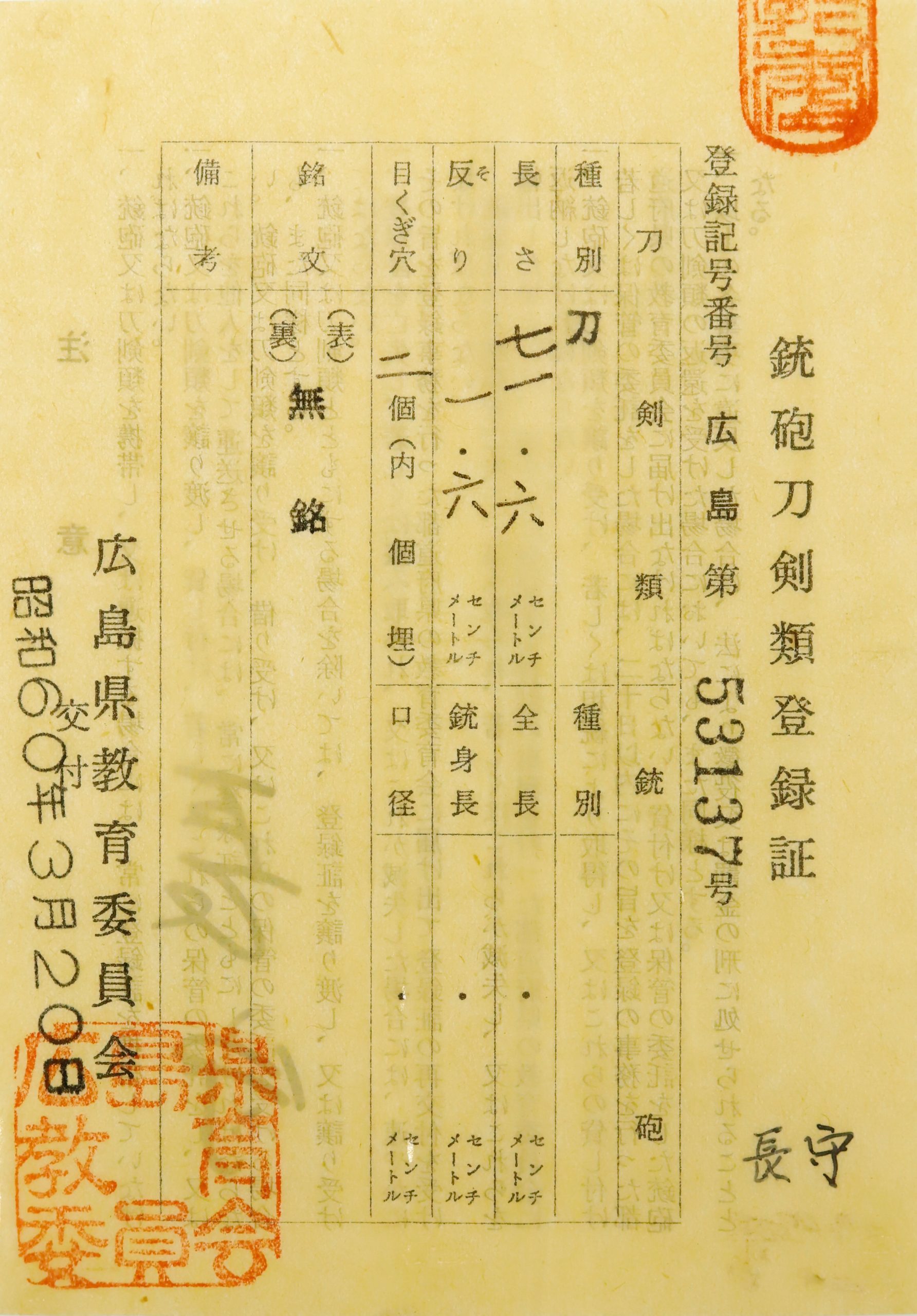
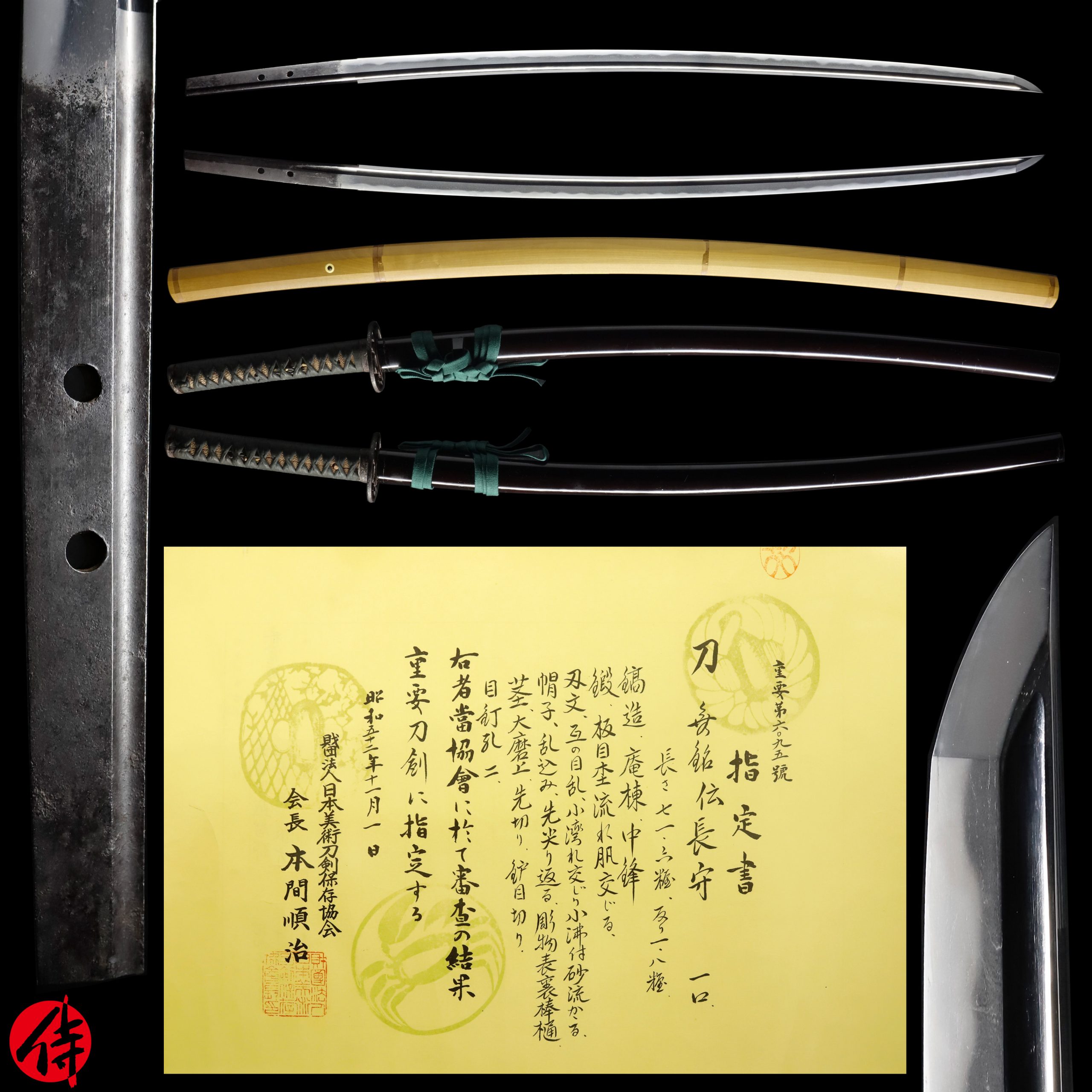
—————————————————————–
【About us】
Samurai Museum is located in Tokyo, Japan, exhibiting antique artifacts related to the Samurai history. Samurai Museum Shop is the place for those who are interested in Japanese culture and craftsmanship. We deal with antique Samurai swords/armor, traditional crafts made in Japan and so on.
【Japanese Sword& Export Process】
The Japanese swords we deal with are hand-forged edged swords made in Japan. It was made from the traditional carbon steel called TAMAHAGANE(玉鋼). Samurai Museum is familiar with the proper legal procedure for an antique/ authentic Japanese sword to be exported from Japan. We have sent more than 400 Japanese swords for the past three years (~2022) to amazing owners who appreciate its historical value.
Each Japanese sword is registered under the Agency for Cultural Affairs and the Board of Education in Japan. They issue a registration paper for each Japanese sword for its owner in Japan to legally possess it. The Japanese sword with its registration paper means it was traditionally hand-forged in Japan.
To legally export the sword from Japan to other countries, we will have to apply for its permit to the Agency for Cultural Affairs(Bunkacho) and return the original registration paper to the Board of Education. It normally takes around 2-4 weeks to receive this permit after submitting required documents. And we would like you to expect at least 1-1.5 months for your order to arrive at your given address after you ordered. For more detailed info, please click here.
It is allowed for residents in Japan to own authentic Japanese swords without a special license as long as they come with registration papers. Please feel free to contact us if you are a resident of Japan, whether temporarily or permanently. We will also assist you when you leave Japan and need to obtain the export permit.
【Payment Method】
We accept payment through Stripe (Credit card), PayPal, Apple Pay or ChromePay, all of which are secure payment methods. Also, you don’t need to make an account on Stripe for the checkout. If you prefer other payment method, please contact us. After confirming your payment, we will apply for an export permit. You may either pay in JPY, USD, AUD, CAD,EUR or GBP. The price is set in Japanese Yen. Prices in other currencies are automatically calculated based on the latest exchange rate.

* If the amount is above 1 million JPY, Stripe or wire transfer will be the only options for payment.
【Shipping】
We have shipped authentic Japanese swords to the USA, UK, Canada, Mexico, Germany, Switzerland, France, Hong Kong and Australia. If you don’t live in these countries and like to order, please contact us first before making a purchase. We offer Free International Shipping as long as we can send antique Japanese swords by either EMS or FedEx(Canada).
We normally ship by EMS(Express Mail Service) provided by Japan Post. When we receive an order from the Canada we will use FedEx instead as EMS temporarily stops shipping from Japan to those countries due to COVID-19.
We will send you a tracking number for your order as soon as we hand it to the post office/FedEx. We will put 100 % insurance on the shipping document without any extra charge. Based on the total amount, there might be a duty tax or other fee for you to pay, depending on the countries. We use package cushioning to protect the item and put it in a PVC pipe, which is one of the most secure packages because of its durability.
It will normally takes 5-14 days for the item to arrive at your given address after we dispatch it. Time of delivery is estimated as accurately as possible by the carrier but does not take into account any delays beyond our control such as by inclement weather, post office holiday seasons.
* If you live in Australia and like to purchase an authentic Japanese sword, please click here to know the detail.
*Please keep in mind that due to the spread of COVID-19, there might be delays in shipping. If you like to know the detail about shipping, please feel free to ask us.

【How to make sure the condition】
Please keep in mind that what you are going to purchase is an antique item. We uploaded high resolution photos for you to check its condition thoroughly. If you like to see more photos with different angles, please feel free to contact us. We will be happy to send them to you so that you can make informed decision. It is essential for us to know that you are happy with your choice of a sword. and we are prepared to use the best of our ability to serve you.
【How To Contact Us】
Please contact us through email, Facebook Messenger or Live Chat if you have any questions. You can find each icon on the right side of the website. Please click one of them to reach us. We will reply to you within 1-2 business days.
【The Art of Nihonto(Japanese Sword)】
Samurai’s history is a profound, eloquent legacy of ancient Japanese warriors in which millions of people worldwide are being fascinated. If you like to find out the art of Nihonto, please click here.
【A Guide to Japanese Sword Maintenance】
After acquiring an genuine Japanese sword, it is also important to know how to take good care of it. Here is the special video for you. Mr. Paul Martin, Japanese sword expert, shows you how to give proper maintenance to your sword. By mastering how to clean the Japanese sword, its aesthetic beauty will last forever.
When you purchase a Japanese sword from us, you can get a Free Japanese sword maintenance kit. It comes with four tools(Choji Oil, Uchiko Whetstone Powder, Peg remover, Oil Applicator). By watching the video instruction above , you can enjoy learning how to maintain your Japanese sword while appreciating it. If you have any difficulty assembling the sword or cleaning the blade, you can feel free to contact us.


MORE ANTIQUE JAPANESE SWORD FOR SALE
LEARN JAPANESE SWORD TERMINOLOGY
Thank you for reading all the information on the page. If you have any difficulty choosing the right Japanese sword for you, we will be more than happy to help you find the one that speaks to you the most. Please feel free to contact us.

